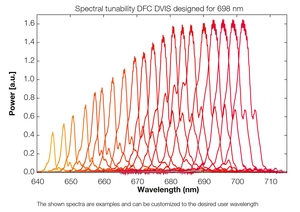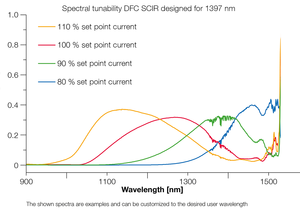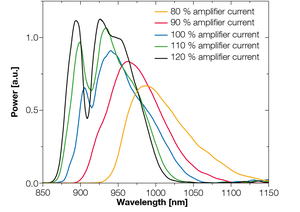
DFC Wavelength Extensions
Wavelength conversion from 1560 nm to 420 - 2000 nm
- Modular extensions
- For use with DFC CORE +
- Independent remote control of different extensions
- Up to three extensions per DFC EXT
- Custom extensions and beat detection in DFC EXT housing
Various extension modules are available that convert the offset-free fundamental output of the DFC CORE + from 1560 nm to any desired wavelength between 420 nm and 2000 nm. The wavelength conversion in these modules is achieved with the well-established technology of TOPTICA’s ultrafast fiber lasers. All extension modules use highly stable all-fiber amplification, nonlinear conversion and compression. The output power of all extension modules allows for phase-locking of cw lasers. Special wavelength extensions are available on request or included in TOPTICA's complete stabilized laser systems.
-
Specification
Extension DFC frep Design wavelength within … Bandwidth (FWHM)* Tunability IR 200 1560 nm 80 .. 100 nm, pulse duration < 100 fs - 80 1560 nm 80 .. 100 nm, pulse duration < 100 fs - SCIR 200 980 .. 2000 nm typical 150 .. 300 nm typical 300 nm 80 980 .. 2000 nm typical 100 .. 300 nm typical 300 nm SCNIR 200 860 .. 980 nm typical 30 .. 60 nm typical 100 nm 80 840 .. 980 nm typical 20 .. 60 nm typical 100 nm NIR 200 780 nm > 20 nm - 80 780 nm > 20 nm - VIS-L 200 640 .. 860 nm typical 1 .. 8 nm 60 .. 80 nm*2 80 640 .. 860 nm typical 1 .. 18 nm 60 .. 80 nm*2 VIS-S 200 450 .. 640 nm typical 0.3 .. 3 nm 80 .. 100 nm*2 80 420 .. 640 nm typical 0.3 .. 3 nm 80 .. 100 nm*2, *3 * please inquire for more bandwidth
*2 service operation necessary for adjustment of design wavelength to new value within tunability range
*3 tunability below 450 nm is limited - Additional Information
- Applications
- Downloads
- Literature
- Related Products



